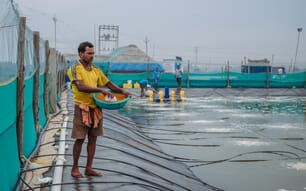
The disease is characterised by saddleback lesions, fin rot, and haemorrhaged gills © Abdulmalik Oladipupo
Lead author, Abdulmalik Oladipupo from Auburn University, explains to The Fish Site how the trials were conducted and the implications of their results.
Why were you conducting the research?
Catfish species – mostly channel and hybrid catfish – account for the largest proportion of US aquaculture production. Pond environment control and water quality maintenance make high stocking densities in catfish ponds achievable, allowing farmers to grow more catfish per acre.
However, such growing conditions have led to more frequent disease outbreaks in catfish ponds, causing substantial losses to farmers. Flavobacterium covae, a gram-negative bacterium causing columnaris disease in catfish, has been a devastating pathogen, particularly during seasonal temperature changes. This lethal strain, characterised by saddleback lesions, fin rot, and haemorrhaged gills, leaves a distinctive “haystack” appearance when affected tissues are observed under the microscope.
US farmers have been combating this disease with antibiotics and chemical therapeutants, a practice that raises concerns about the sustainability of catfish aquaculture and the potential implications for consumers' health due to the transfer of antimicrobial-resistant pathogens.
Our research represents a significant step towards a sustainable solution for the catfish industry. It investigated the potential of dietary supplementation with natural additives that have shown promising clinical application in animals and other fish species. The inclusion of an exogenous protease enzyme, a bacteria fermentation by-product, or a humic substance extracted from reed-sedge peat moss in practical catfish diets could potentially provide sustainable management of columnaris disease in catfish, inspiring and motivating the farmers to implement these solutions.
How affordable and accessible are these additives?
The inclusion level is relatively small, but the economics were not covered in the scope of the study and are yet to be investigated in detail. This will be incorporated into future studies, especially from a farm-scale perspective.
As for accessibility, there are already a range of both dietary protease and humic products on the market, including the ones used in this study, which the results and conclusion were drawn from.
What did the trial involve?
In the short-term feeding trial (60 days) in a recirculatory system, a low-protein diet containing 28 percent protein with soybean and bone meal as the primary protein source was supplemented with either protease enzyme (175g per tonne) or humic substance (23g per tonne). The aim was to bolster catfish growth and immunity, thereby enhancing their resistance to columnaris disease. These practical diets were offered to channel catfish fingerlings along with a control diet of low protein and a high protein diet, which included fishmeal. Following the feeding trial, the different dietary groups of catfish were challenged with Flavobacterium covae for 8 days. We also investigated health indicators from tissue samples from fish post-feeding and post-challenge trials.

What were the key results?
1. Growth
The results showed that growth metrics were not affected by the inclusion of protease enzyme or humic substance after a 30- or 60-day feeding period, but the high-protein dietary control groups showed general growth improvement. The low-protein supplemented feed led to better growth compared to the similar feed without additives.
2. Immunity
Although the trial found that no influence of protease enzyme or humic substance was shown following the feeding of supplemented diet, an innate immune response studied by investigating lysozyme activity in the blood showed that catfish fed either the protease or humic substance had improved innate immunity response in a response to the bacteria challenge activity. In addition, they observed an increase in immune-related genes in the kidney of fish offered a humic substance-supplemented diet after exposure to bacteria.
3. Resistance to columnaris disease
In response to F. covae infection, catfish survival was significantly improved in catfish fed either protease or humic substance, as the lowest mortality (~25 percent) was shown following infection. In the catfish group fed the control diets, mortality up to ~60 percent was demonstrated in the high protein fishmeal and ~45 percent in the low and high protein soy diet. The research suggests that humic substances and protein enzymes could stimulate catfish's immune response to protect them against columnaris disease.

© Abdulmalik Oladipupo
What are the implications of your results for the catfish industry?
The study suggests that both the protease enzyme and humic substance could be applied to commercial catfish aquafeeds. They enhance the immune system and resistance to lethal bacterial infection and have no adverse effects on fish growth. This could be crucial for mitigating fish losses in catfish farms.
It also suggests that low-protein soy diets containing proteases and humic substances should be considered better alternatives to high-protein diets that include fishmeal. Protease enzymes can break down complex amino acids and degrade anti-nutritional factors, which are prominent in soybeans.
Furthermore, the study inferred that humic substances, although their application is new in fish, could stabilize intestinal microflora in catfish, thereby enhancing nutrient utilization in fish feed. At relatively low inclusion levels, these additives showed practical value as immunostimulants for channel catfish production. As in this study, the two additives were included at the diet formulation level, which makes it commercially replicable.
These dietary immunostimulants might also have advantages over natural alternatives, such as probiotics and prebiotics, which may present stability and handling challenges in large-scale applications.
While the catfish industry continues to thrive mainly in traditional production environments, dietary stimulating alternatives remain one of the promising alternatives for disease treatment and growth promotion.
How do you intend to follow up the study?
We are already in the process of conducting further research to establish the connection and mode of action of both additives in catfish. Furthermore, we are currently conducting outdoor farm trials outside the lab, which will provide information on the impact in a less controlled environment as well as determine the impact of the long-term application of these additives on catfish growth and health.
Further information
More details of the study, which was published in the Journal of Fish Diseases, can be found here.




